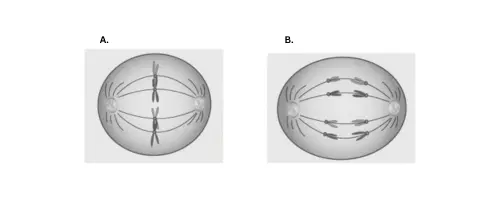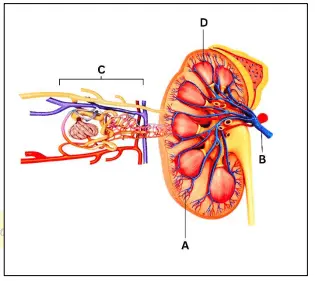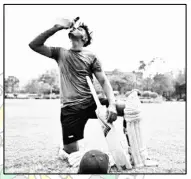ICSE Class 10 Biology Competency Focused Practice Questions Solution:
Multiple Choice Questions (1 mark each)
Question 1
Rita suffers from constant headaches and high blood pressure. Her residence is close to an airport. What could be the most likely cause of her condition?
(a) Noise pollution
(b) Air pollution
(c) Nuclear pollution
(d) Water pollution
Answer: (a) Noise pollution
Explanation: Prolonged exposure to high levels of noise due to airplanes can cause stress, increase blood pressure, and result in headaches.
Question 2
An exo-endocrine gland in the human body is:
(a) Pituitary gland
(b) Pancreas
(c) Salivary gland
(d) Adrenal gland
Answer: (b) Pancreas
Explanation: The pancreas is also called a mixed gland or an exo-endocrine gland because it works both as exocrine and endocrine gland. It secretes digestive enzymes into the small intestine via ducts (exocrine) and produces hormones like insulin and glucagon, which are released directly into the bloodstream to regulate blood sugar levels (endocrine).
Question 3
Assertion: If both kidneys fail, urea from the blood is removed by dialysis.
Reason: Accumulation of urea in the human body is toxic.
(a) A is True, and R is false.
(b) A is False, and R is true.
(c) Both A and R are true.
(d) Both A and R are false.
Answer: (a) Both A and R are true.
Explanation: Dialysis is a medical process used to remove waste products like urea from the blood when the kidneys are not functioning properly. Urea is a waste product produced in the body and its accumulation is dangerous for the body.
Question 4
Rajesh was told to buy a blue cloth by his craft teacher. He couldn’t differentiate blue colour from green and hence brought a green cloth to class. Which medical reason could have resulted in this?
(a) Myopia
(b) Cataract
(c) Colour blindness
(d) Hyperopia
Answer: (c) Colour blindness
Explanation: Colour blindness is genetic condition in which the patient is not able to differentiate between the colours.
Question 5
Mary sprinkled 5 kg of common salt on the grass growing on her lawn. After a couple of days, she observed that the grass had wilted and died. This was due to which of the following conditions?
(a) Endosmosis
(b) Turgidity
(c) Deplasmolysis
(d) Plasmolysis
Answer: (d) Plasmolysis
Explanation: The salt makes the soil solution hypertonic. When cells come in contact with the soil solution, the cell sap comes out by exosmosis resulting in shrinkage of cell known as plasmolysis. Plasmolysis cause wilting of plant.
Question 6
In cholera, patients suffer from vomiting and watery bowels. They may die due to the:
(a) poisoning by the accumulation of high quantities of urea in the body.
(b) ability of the intestines to absorb water into the blood.
(c) excretion of almost all the water by the kidneys.
(d) the failure of the kidneys.
Answer: (a) poisoning by the accumulation of high quantities of urea in the body.
Explanation: Due to vomiting and watery bowels, the intestine is unable to absorb water into the blood. Therefore, to maintain the osmotic pressure of blood, kidneys reabsorb almost all the water and urea. This causes poisoning by the accumulation of high quantities of urea in the body.
Question 7
The given figures A and B show …………… and …………… stages of cell division.
(a) prophase, metaphase
(b) telophase, anaphase
(c) metaphase, anaphase
(d) anaphase, telophase

Answer: (c) metaphase, anaphase
Explanation: During metaphase, the chromosomes align themselves along the equatorial plane of the cell. In anaphase, the sister chromatids of each chromosome are pulled apart by the spindle fibers towards the opposite poles of the cell. The centromeres split, and the chromatids move away from the center.
Question 8
A person is suffering from kidney failure. He is put on a dialysis machine by the doctors. The osmotic pressure of dialysis fluid should be:
(a) equal to that of blood.
(b) more than that of blood.
(c) less than that of blood.
(d) equal to zero.
Answer: (a) equal to that of blood.
Explanation: In dialysis, the osmotic pressure of the dialysis fluid should be equal to that of blood to prevent excessive movement of water either into or out of the blood. This ensures that waste products like urea and excess salts are removed without causing an imbalance in fluid levels in the body.
Question 9
A squirrel is in a scary situation. The secreted adrenaline prepares the body to meet the situation. Which of the following is NOT TRUE for this situation?
(a) Adrenaline prepares the body to fight danger.
(b) Extra energy and strength are provided to the body.
(c) At the time of the stress, fewer hormones are released into the blood.
(d) Adrenaline prepares the body to run away from danger.
Answer: (c) At the time of the stress, fewer hormones are released into the blood.
Explanation: In a scary situation, more hormones are released into the bloodstream to help the body cope with the situation.
Question 10
Assertion (A): The main pulmonary artery pumps oxygenated blood from the right ventricle into the lungs.
Reason (R): Inside the lungs, the artery divides and divides several times to form capillaries around the air sacs.
(a) A is True, and R is false.
(b) A is False, and R is true.
(c) Both A and R are true.
(d) Both A and R are false.
Answer: (b) A is False, and R is true
Explanation: The pulmonary artery pumps deoxygenated blood from the right ventricle to the lungs for oxygenation. The oxygenated blood is returned from lungs to the heart through the pulmonary veins.
Question 11
Given below are some common reflexes in humans.
i. Quick closing of the eyelids when a strong beam of light is flashed across.
ii. Apply brakes to your vehicle if anything suddenly comes in front.
iii. Playing a musical instrument.
iv. Coughing reflex, when the food is swallowed, enters the windpipe.
The conditioned reflexes are:
(a) i and ii
(b) ii and iii
(c) iii and iv
(d) i and iv
Answer: (b) ii and iii
Explanation: Playing a musical instrument and applying brakes are learnt by practice and thus they are conditioned reflexes.
Question 12
Electrons released on splitting of water molecules in photosynthesis are used in producing:
(a) NADP
(b) NADPH
(c) ATP
(d) O2
Answer: (c) ATP
Explanation: During light dependent phase of photosynthesis, the electrons released on splitting of water molecules are used in converting ADP into ATP.
Question 13
The four major steps in seeing an object are:
i. interpretation by the brain.
ii. focussing of image.
iii. entry of light rays.
iv. transmission of nerve impulses from the retina & brain.
The correct sequence will be:
(a) i, ii, iii, iv
(b) ii, iii, iv, i
(c) iii, ii, iv, i
(d) iv, i, ii, iii
Answer: (c) iii, ii, iv, i
Explanation: First, the light enters from cornea, then image is focussed on retina, the nerve impulses are then transmitted by optic nerve from the retina & brain and at last the brain interprets it.
Question 14
Based on the given figure, identify the structural as well as the functional unit of kidney:

(a) A
(b) B
(c) C
(d) D
Answer: (c) C
Explanation: The part C in the picture is a nephron. It is the structural and functional unit of kidney.
Question 15
Assertion: Seminiferous tubules produce sperms.
Reason: Seminiferous tubules secrete Oxytocin, which aids in the production of sperm.
(a) A is True, and R is false.
(b) A is False, and R is true.
(c) Both A and R are true.
(d) Both A and R are false.
Answer: (a) A is True, and R is false.
Reason — The seminiferous tubules are the site of spermatogenesis (the production of sperm cells). However, Oxytocin is a hormone primarily works during childbirth and lactation in females.
Question 16
Assertion: The nerve impulse travels from the axon of a neuron to the axon of another neuron.
Reason: The end portion of the axon has swollen ends, which store neurotransmitters.
(a) A is True, and R is false.
(b) A is False, and R is true.
(c) Both A and R are true.
(d) Both A and R are false.
Answer: (b) A is False, and R is true
Explanation: The nephrons are arranged in such a way that the nerve impulse travels from the axon of one neuron to the dendrite of another neuron across a small gap called as synapse.
Question 17
Thomas played cricket on a hot summer afternoon. His urine output was much less, though he drank plenty of water. What could be the possible cause?

P – Kidneys reabsorb a lot of water
Q – Sweat glands are active
R – Kidneys absorb less water
S – Sweat glands are inactive
(a) R and Q
(b) P and Q
(c) P and S
(d) R and S
Answer: (b) P and Q
Explanation: While playing, the player loses most of water in the form of sweat through sweat glands. Therefore, the kidneys reabsorb most of the water back in the blood to maintain the osmotic pressure of blood. This results in less volume of urine.
Question 18
Acid rain is caused due to polluted gases like CO2, SO2, and oxides of nitrogen. The pollution which does not take place immediately after acid rain is:
(a) Air pollution
(b) Water pollution
(c) Soil Pollution
(d) Noise Pollution
Answer: (a) Air pollution
Explanation: After rainfall the air pollutants are washed away with rain droplets.
Question 19
Surya’s father was diagnosed with Diabetes mellitus. The doctor advised him to avoid certain foods. Which are the foods he should avoid eating?
P – Sweets
Q – Leafy vegetables
R – Bananas
S – Pulses
(a) P and R
(b) Q and S
(c) R and S
(d) P and Q
Answer: (a) P and R
Explanation: Sweets and bananas have high sugar content and therefore, they can spike the blood glucose level.
Question 20
During light adaptation:
(a) Rods and cones become active.
(b) Rods and cones become inactive.
(c) Rods become active and cones inactive.
(d) Cones become active and rods inactive.
Answer: (d) Cones become active and rods inactive.
Explanation: The cones, are sensitive to bright light and are responsible for colour vision and sharp vision in bright conditions.
Question 21
A cell of a leaf of an aquatic plant is kept in a 5% salt solution for some time. The phenomenon which will take place is/are:
(a) turgidity
(b) plasmolysis
(c) turgidity and flaccidity
(d) plasmolysis and flaccidity
Answer: (d) plasmolysis and flaccidity
Explanation: When a cell of an aquatic plant is kept in a 5% salt solution (hypertonic), water will move out of the cell (exosmosis). This causes the cell membrane to shrink away from the cell wall, leading to plasmolysis. As a result, the cell will become flaccid.
ICSE Related Links
Chapter-wise Quiz/MCQ/Test:
ICSE Chapter wise Quiz For Class 6
ICSE Chapter wise Quiz For Class 7
ICSE Chapter wise Quiz For Class 8
ICSE Chapter wise Quiz For Class 9
ICSE Chapter wise Quiz For Class 10
Sample Papers
Board Papers
ICSE Class 9 Board Exam Papers
ICSE Class 10 Board Exam Papers
CBSE Related Links
Chapter wise Quiz/MCQ/Test
CBSE Chapter-wise Quiz for Class 6
CBSE Chapter-wise Quiz for Class 7
CBSE Chapter-wise Quiz for Class 8
CBSE Chapter-wise Quiz for Class 9
CBSE Chapter-wise Quiz for Class 10
Sample Papers
Board Papers
CBSE Class 10 Previous years’ Board Papers
Subscribe to our YouTube channel for more educational content.

